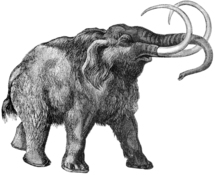
Conventional wisdom has held that mammoths died out in northwestern Europe some 21,000 years ago during a deep freeze called "the last glacial maximum."
But the new research, published in Britain's Geological Journal, proves that the giant tuskers of prehistory hung on for at least another six millennia.
"Our new radiocarbon dating of the Shropshire mammoths shows they returned to Britain and survived until around 14,000 years ago," said Adrian Lister, a professor at the Natural History Museum in London and author of the study.
Previous techniques used for dating the fossils were not very accurate, he explained.
The giant mammals flourished during the initial phase of the last Ice Age but, despite their "woolly" coats, could not cope with its bitterest chill.
The British mammoths headed south and east towards slightly warmer climes, crossing a land bridge to continental Europe when sea levels were up to 100 metres (325 feet) below what they are now.
The mammoths came back when the glacial maximum eased and then survived until the end of the Ice Age, when encroaching forests gradually destroyed their food supply, Lister told AFP by phone.
"Mammoths were basically a grass-eating animal. During the Ice Age, the environment across most of Europe was essentially grassland because it was too cold for trees," he explained.
As it got warmer, trees spread northward and covered the whole of Europe, robbing these animals of their habitat.
"Their populations were squeezed down into remnants and then disappeared altogether," Lister said.
Lister said the persistence of these mythic animals in what is today central England is probably an example of "extinction lag," whereby small pockets survive even as the species as a whole disappears from the planet.
Other giant mammals that vanished in Europe as the last ice age relented and human populations began to expand include the woolly rhino, horses, red and giant deer and bison.
Similar die-outs of these so-called "megafauna" occurred around the world about the same time, prompting scientists to ask which was more to blame, the shifting climate or human predators.
Lister said human hunters may have finished off the surviving pockets of mammoths but were probably not the main cause of their demise.
--------------------------------------------------------------------------------------------------------
But the new research, published in Britain's Geological Journal, proves that the giant tuskers of prehistory hung on for at least another six millennia.
"Our new radiocarbon dating of the Shropshire mammoths shows they returned to Britain and survived until around 14,000 years ago," said Adrian Lister, a professor at the Natural History Museum in London and author of the study.
Previous techniques used for dating the fossils were not very accurate, he explained.
The giant mammals flourished during the initial phase of the last Ice Age but, despite their "woolly" coats, could not cope with its bitterest chill.
The British mammoths headed south and east towards slightly warmer climes, crossing a land bridge to continental Europe when sea levels were up to 100 metres (325 feet) below what they are now.
The mammoths came back when the glacial maximum eased and then survived until the end of the Ice Age, when encroaching forests gradually destroyed their food supply, Lister told AFP by phone.
"Mammoths were basically a grass-eating animal. During the Ice Age, the environment across most of Europe was essentially grassland because it was too cold for trees," he explained.
As it got warmer, trees spread northward and covered the whole of Europe, robbing these animals of their habitat.
"Their populations were squeezed down into remnants and then disappeared altogether," Lister said.
Lister said the persistence of these mythic animals in what is today central England is probably an example of "extinction lag," whereby small pockets survive even as the species as a whole disappears from the planet.
Other giant mammals that vanished in Europe as the last ice age relented and human populations began to expand include the woolly rhino, horses, red and giant deer and bison.
Similar die-outs of these so-called "megafauna" occurred around the world about the same time, prompting scientists to ask which was more to blame, the shifting climate or human predators.
Lister said human hunters may have finished off the surviving pockets of mammoths but were probably not the main cause of their demise.
--------------------------------------------------------------------------------------------------------









 Home
Home Politics
Politics









